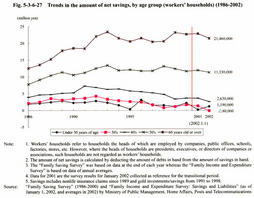| Previous Next Index Image Index Year Selection | |
|
|
6 Social backgrounds of attacks against elderly people (1) Aging society One of background factors behind the increase in the number of heinous offenses targeting elderly people is the progress in the aging of the society. Fig. 5-3-6-25 shows the population trends for every 10 years over the 30 years from 1973 to 2002, by age group (0-19, 20-59, and 60-64/65 or over). According to the percent distribution, the percentage of people aged 0-19 (total of males and females) decreased from 31.8% to 19.9% whereas the percentage of elderly people aged 60 or over (total of males and females) increased from 11.3% to 24.9% (the number of those aged 65 or over also increased from 7.5% to 18.5%).
Fig. 5-3-6-25 Percent distribution of people, by age group (1973, 1983, 1993, 2002) (2) Increase in households in which elderly people live alone or only with their spouse The increase in the number of cases in which elderly people who live alone or only with their spouse are victimized by robbery at home results from the increase in the number of households in which elderly people live alone (elderly-single-person households) or only with their spouse (elderly-couple households). Fig. 5-3-6-26 shows the trends in the percentages of elderly-single-person households and elderly-couple households (Source: Population Census; people aged 65 or over are regarded as elderly people, and a couple consisting of a husband aged 65 or over and a wife aged 60 or over is regarded as an elderly couple) in all households over the 20 years from 1980 to 2000. The percentage of elderly-single-person households and the percentage of elderly-couple households have increased by 4.0 points, from 2.5% to 6.5% and by 4.9 points from 2.9% to 7.8% respectively.
Fig. 5-3-6-26 Percentage of elderly-single-person households and elderly-couple households (3) Other background factors As robbery is an offense committed with the intention of taking money or articles, it is inevitable that people who possess a lot of cash or highly cashable financial property are frequently targeted for robbery. Another background factor for the increase in robbery cases targeting elderly households is the increase in elderly households that own relatively large amounts of financial property despite the recession. Fig. 5-3-6-27 shows the trends in the amount of net savings of financial property (the outstanding amount of savings minus the outstanding amount of debts), by age group of household. Elderly households headed by people aged 60 or over have more financial property than households in other age groups, and the gap in the amount of property is widening between elderly households and households in other age groups, and in particular, younger households including those headed by people in their 40s. This may also be another social background factor that causes robbery cases targeting elderly households.
Fig. 5-3-6-27 Trends in the amount of net savings, by age group (workers' households) (1986-2002) |


